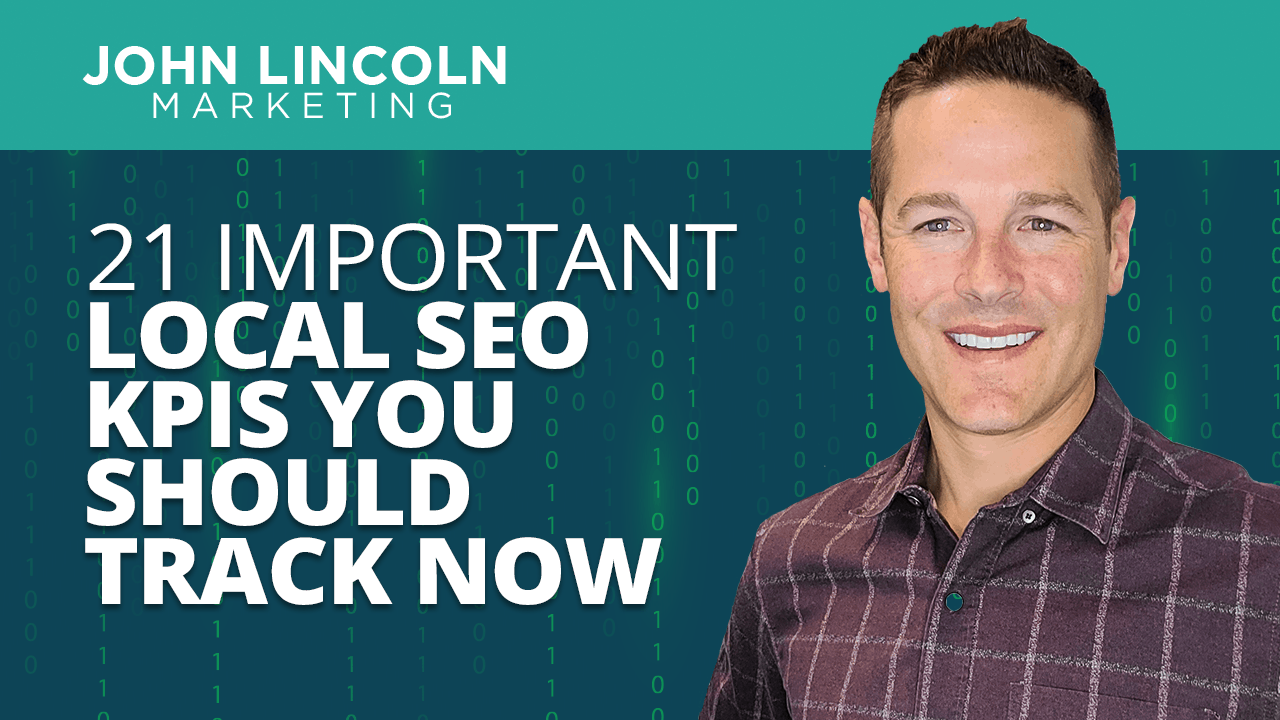21 Important Local SEO (KPIs) You Should Track Now
Local SEO can have a major impact on your brick-and-mortar business. But how do you know if your local SEO is doing well? Well, it is all about KPIs.
These 25 metrics for local SEO will serve as key performance indicators (KPIs) to keep your business moving in the right direction.
1. Google My Business Insights

There are plenty of Google My Business metrics to look at, but these ones tend to carry the most weight:
- Page Views
- Engagement
- Customer Actions (especially phone calls, form submissions, contact views, direction requests, chats, and downloads)
The different customer action insights are especially useful for brick-and-mortar businesses seeking local foot traffic. You can even use photo views, which shows how often people view your business’ photos compared to the competition.
2. Local Listings
Look at your local listings and find out what percentage of them are correct vs. incorrect.
How do you find all the listings for your business? Fortunately, you don’t have to do it manually. You can use tools such as:
- Yext
- MozLocal
- HooverAll
- Uberall
You also want to remove any duplicate listings, as it can negatively impact your SEO performance. Duplicate listings create clutter and split reviews between listings. Your best bet is to eliminate them, not suppress them.
3. Reviews Serve as Metrics for Local SEO

Look at the number of reviews generated for your local business. Measure the number of monthly reviews against overall reviews.
Look at the following sites for review metrics:
- Google My Business
- Yelp
- Bing Local Listings
Knowing that you’ve generated reviews can be a good sign, but it’s important to understand how many reviews and what the majority review sentiment is.
4. Bring HTML Into the Picture
There are six ways to use HTML metrics for local SEO.
- Find out overall traffic for your local HTML page.
- Determine what keywords (and how many keywords) you’re targeting.
- Find out your visibility index, which is the average of where you’re keywords are ranking.
- What’s your number of conversions (overall, each market, each month)?
- Report your ranking for HTML pages.
- What’s the percentage of pages with SERP features?
RELATED: 19 Technical SEO Issues That Kill Rankings + Fixes
5. Branded Searches

While it’s important to look at your overall organic search traffic, why not hone the data? You can do this by determining what percentage of your organic search comes from branded searches.
Mastering your own brand’s term is a surefire way to improve brand relevance and foot traffic.
6. Keep Your Eye On Advertising Spend
Measuring your ad spend is important because you want to know your return on ad spend (ROAS).
Here’s how to calculate ROAS:
ROAS = Revenue Earned From Advertising / Advertising Expense
Tracking revenue from digital ad spend for an in-person store can be difficult, but pixels and other tools are very helpful in connecting the dots. Most local ad platforms also offer in-store visit tracking as well.
7. Average Page Load Time

Google Analytics, and other solutions such as the Google Page Speed Test, can tell you your page load time. Page speed factors heavily into search engine results (Google reports that a good page load speed is under two seconds).
If your page speed is subpar, you’ll know that you have some developmental issues to work on. You may need to enable compression, minify coding, reduce redirects or another common resolution.
A faster page means a lower bounce rate and a higher ranking on the search engine results pages in some cases.
8. Conversion Rate
The conversion rate metrics for local SEO are two-fold.
First, find out the conversion rate for each local page by market.
Second, find out conversion rates on specific landing pages for your business.
You’ll also want to benchmark your conversion rates before and after different ad campaigns (whether they be digital or in-person). This will allow you to optimize your efforts and, ultimately, improve local SEO over time.
9. Cost Per Conversion
Conversions are important, but what also matters is how much those conversions cost. Enter cost per conversion (CPC).
Tracking this cost data means making sure your SEO is paying for itself. The general calculation for CPC is:
CPC = Leads Generated / Cost of SEO Campaign
Don’t include fluctuating ad spend or bidding for placement in this equation. You’ll be able to pit the result against your revenue from those conversions to determine whether or not your CPC is suitable. You can adjust your marketing efforts accordingly to ensure you’re getting the most bang for your buck.
10. Click-Through Rates

Your click-through rate (CTR) is the rate at which users are clicking on your ads or organic SEO results.
Find out your CTR for different campaigns. You especially want to know CTR for individual keywords (and pages) so you can optimize which terms you are targeting over time.
For local SEO, a page view may translate directly to an in-person sale, so this metric is crucial.
11. Local Search Ranking
You will want to track where your Google My Business page is ranking for specific terms and that you show up in the local Google Maps.
But also, many local searches bring back unique features such as the ability to book a reservation at a restaurant. It is important you audit all your local features and enable the ones most important to your business.
Here is a list of some of the things you can create with schema that may be helpful. Pick and choose the ones you want to use for your local SEO strategy.
- How-Tos
- Local 3-Pack
- Rich Snippets
- Sitelinks
- Top Stories for News
- AMP
- Reviews
- Knowledge Panel
- Google for Jobs
- Recipes
- Carousel
- Podcast
- Quotes
- Events
- Datasets Search
- Movie Carousel
- Send to Google Home
12. “Near Me” Searches
Over the last few years, “near me” search queries have grown in popularity at least two-fold. According to Google, they’re not growing as rapidly as other types of search queries. But the fact that local searches account for about a third of our searches says a lot.
Needless to say, knowing if you’re ranking in any “near me” searches plays a big role in your success as a storefront.
13. Traffic Pattern Metrics
Looking at website traffic patterns helps you determine what’s contributing to the growth and/or decline of your digital presence.
That’s why you want to look at traffic patterns that show:
- Growth and decline for individual keywords
- Growth and decline for overall traffic
It’s important to look at where you’re succeeding and where you’re struggling so you can streamline your site across the board.
14. New Sessions and New Users
Measuring new sessions and users is a straightforward way of quantifying your reach. These metrics for local SEO show you how well you’re attracting new audiences.
You can even break them down further by city, page title, and more.
15. Number of Organic SERPs
How many SERPs are you showing up on? This is a tell-tale sign for your organic reach. The more SERPs you’re able to show up on without paying for ads, the higher your ROAS will be (and the lower your CPC and CPA).
Keep in mind Google’s different SERP features (for example, the local pack). It’ll be easier to find your way into this digital real estate if you measure your performance.
16. Keep Track of Your Backlinks
Your backlink profile can help strengthen your local SEO and guide you to new audiences.
Companies like Ahrefs have a backlink checker for you to keep track of this metric. You can determine your domain authority (DA), number of backlinks, percent of do-follow links, number of referring domains, percent of do-follow referring domains, and more.
17. Bounce Rates
A high bounce rate is costly for local businesses. Measure and address your bounce rate to make sure you’re not losing out on valuable sales.
There are lots of ways to measure bounce rate automatically, but the equation comes down to your rate of one-page visits divided by total website entries. Bounce rate is a little different from an exit rate because it measures people who visit your site without visiting any other pages.
Paired with dwell time, bounce rate is an intuitive local SEO metric.
18. Response Time
When it comes to local messaging, response time matters. Sites like Google My Business and Facebook track how long it takes you to respond to a message. You can either have a customer service person manage the messages, create a chatbot or have a combination of the two. Regardless of how you approach it, you want to be as fast as possible.
19. Geo-Targeting
When it comes to local SEO, your site structure might look something like this.
National Pages
- Country Pages
- County Pages
- State Pages
- City Pages
- Zip Code Pages
- Location Pages
- Zip Code Pages
- City Pages
- State Pages
- County Pages
Now, it does not make sense for all websites to have all of these pages. The main point is, you want to track your most important KPIs for each segment of pages. What keywords are they ranking for, CTR in SERPS, traffic, conversions and more.
20. Non-Branded Search Terms
Branded queries may make up a big chunk of searches, but they’re not the entire kit and kaboodle. Non-branded searches also have a hold on local SEO.
Non-branded search terms include key phrases that aren’t your brand or company name.
Google Search Console can help you differentiate your branded/non-branded split.
21. The Last of Our List of Metrics for Local SEO: Top Exit Pages
Exit pages are the last pages your audience visits before leaving your site. Know which pages are the most likely to be exited from so you can prioritize them in your website optimization.
There are many reasons why a page might be one of your top exit pages, so focus on design and layout, page speed, content organization, readability and general quality of the page.
Also, make sure to fire an exit pop up on those pages. We generally see about a 14% increase in conversions with exit pop ups.
Wrapping Up
Local SEO can have a major impact on the success of your local business.
Make sure you stay on top of the SERPs – and top of customer mind – by paying close attention to these twenty-one key metrics.
Welcome To John Lincoln Marketing
Welcome to John Lincoln’s personal website. On this website, we offer courses by John Lincoln, review software, publish articles and videos. You can also learn about John Lincoln’s books, films, book him to speak and contact him. John is directly associated with many of the businesses mentioned on this website and freely discloses this information.
About the Author

John Lincoln is CEO of Ignite Visibility, one of the top digital marketing agencies in the nation. Ignite Visibility is a 4x Inc. 5,000 company. Ignite Visibility offers a unique digital marketing program tied directly to ROI with a focus on using SEO, social media, paid media, CRO, email, Amazon and PR to achieve results. Outside of Ignite Visibility, Lincoln is a frequent speaker and author of the books “Digital Influencer” and “The Forecaster Method.” Lincoln is consistently named one of the top digital marketers in the industry and was the recipient of the coveted Search Engine Land “Search Marketer of The Year” award. Lincoln has taught digital marketing and Web Analytics at the University of California San Diego since 2010, has been named as one of San Diego’s most admired CEO’s and a top business leader under 40. Lincoln has also made “SEO: The Movie” and “Social Media Marketing: The Movie.” His business mission is to help others through digital marketing.
Get Social
Recent Tweets
Contact John Lincoln
Want to get in touch with John Lincoln? Click Here To Reach Out.
Related Posts

The Ultimate Guide to Conversion Rate Optimization for Any Business
Whether you’re a seasoned marketer or just starting out, conversion rate optimization (CRO) is a powerful tool that can boost your sales, leads, and overall

16 Questions to Help You Choose an SEO Company
Feeling overwhelmed by the sea of SEO companies out there? You’re not alone! Choosing the right partner is crucial for achieving your online marketing

Elevate Your Business with Proven Blogging Strategies in 2024
In 2024, business blogging is not only still relevant – it’s a critical component of any content marketing strategy. Companies that blog generate 67% more


